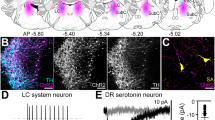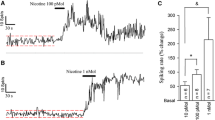Abstract
The serotonergic innervation of the locus coeruleus paetly derives from the dorsal raphe nucleus (DRN). Using the push-pull superfusion technique, we investigated whether and to what extent the release of serotonin and the extracellular concentration of its metabolite 5-hydroxyindoleacetic acid (5-HIAA) in the locus coeruleus are influenced by the neuronal activity of the DRN. In anaesthetized rats, a push-pull cannula was inserted into the locus coeruleus, which was continuously superfused with artificial cerebrospinal fluid (aCSF). Serotonin and 5-HIAA levels in the superfusate were determined by HPLC combined with electrochemical detection. Electrical stimulation (5 Hz, 300 μA, 1 ms) of the DRN for 5 min, or its chemical stimulation by microinjection of glutamate (3.5 nmol, 50 nl), led to an increased release of serotonin in the locus coeruleus and to a slight (2 mmHg) decrease in blood pressure. Superfusion of the locus coeruleus with tetrodotoxin (1 μM) abolished the increase in the release rate of serotonin evoked by electrical stimulation of the DRN, while the slight fall in blood pressure was not influenced. Thermic lesion (75 °C, 1 min) of the DRN elicited a pronounced decline in serotonin release rate within the locus coeruleus, the maximum decrease being 52%. The decrease in the release of serotonin was associated with a long-lasting rise in blood pressure. Microinjection of the serotonin neurotoxin 5,7-dihydroxytryptamine (5 μg, 250 nl) into the DRN led to an initial increase in the serotonin release rate that coincided with a short-lasting fall in blood pressure. Subsequently, the release of serotonin was permanently reduced and was associated with hypertension. Microinjection of the 5-HT1A receptor agonist (±)-8-hydroxy-dipropylaminotetralin (8-OH-DPAT; 7.5 nmol, 50 nl) into the DRN led to a long-lasting reduction of the release rate of serotonin in the locus coeruleus. Microinjection of 8-OH-DPAT into the DRN also slightly lowered blood pressure (3 mmHg). Neither stimulations nor lesion of the DRN, nor microinjection of 8-OH-DPAT into this raphe nucleus, altered the extracellular concentration of 5-HIAA. Judging from the present biochemical results it appears that the serotonergic afferents to the locus coeruleus originate to more than 50% from cell bodies located in the DRN. The neuronal serotonin release in the locus coeruleus is modulated by 5-HT1A receptors lying within the DRN. Changes in blood pressure and release of serotonin elicited by stimulating or lesioning the DRN point to the importance of serotonergic neurons extending between this raphe nucleus and the locus coeruleus in central cardiovascular control.
Similar content being viewed by others
Author information
Authors and Affiliations
Additional information
Received: 5 November 1998 / Accepted: 21 February 1999
Rights and permissions
About this article
Cite this article
Kaehler, S., Singewald, N. & Philippu, A. Dependence of serotonin release in the locus coeruleus on dorsal raphe neuronal activity. Naunyn-Schmiedeberg's Arch Pharmacol 359, 386–393 (1999). https://doi.org/10.1007/PL00005365
Issue Date:
DOI: https://doi.org/10.1007/PL00005365




